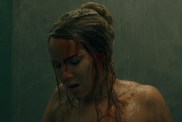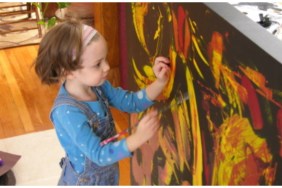Every parent must think their child is the most talented kid in the world and Amir Bar-Lev’s new documentary My Kid Could Paint That takes that idea and uses it to take a look at how the art world determines what should or shouldn’t be considered something of artistic and monetary value.
Bar-Lev spent a year in the lives of 4-year-old Marla Olmstead and her parents as they became the talk of the art world and the media due to Marla’s expressionist paintings, which had many people calling her an art prodigy on the scale of a “young Picasso.” Things are going well with Marla’s rise to fame until a “60 Minutes” piece questions the veracity of the paintings and whether they came solely from Marla’s imagination or whether she was coached or helped by her father or her art dealer, who had been getting thousands of dollars for each of her works.
“I came in about four days after I read the New York Times piece,” Bar-Lev told ComingSoon.net about how he became interested in Marla’s story. “I read it and I picked up the phone and was surprised to be able to get them on the line right away. Any time you hear of a four-year-old becoming a celebrity, I think it raises a bunch of interesting issues about fame and the way childhood is treated these days in pop culture and the way the media works. In this case, the fact that she was being called a prodigy in abstract expressionism added an extra layer of intrigue for me. Had she been a four-year-old chess player or a violinist, there seems to be objective standards that come to bear but with abstract expressionism, there seems to be a lack of those standards. I went into it thinking, ‘Well, this will be an interesting window into questions of art.’ Having said all that, having met the family, I realized that this wasn’t going to play out in some dry way. All these interesting but potentially academic issues were going to play out in a very cinematic way.”
Surprisingly, Bar-Lev didn’t have an art background before getting into the movie, which made Marla’s story that much more interesting to him. “I had the same questions that many people had and that it has to do with those lack of objective standards. One of the things that I’ve learned over the last three years, thinking and talking about this idea, is that just because there aren’t those objective standards doesn’t mean that you can’t judge abstract art. Each person gets to engage with a piece and make up their own mind about it, but it’s also imperative that they learn about why people value that art and learn about how the art was made. One of the differences of opinion I have with Tony [Marla’s art dealer] and Marla’s parents is that when I said to them, ‘Look, I think that the paintings she’s done on-camera are of one caliber and some of the paintings done off-camera are of a different caliber.’ In a way, every person has to make up their own mind watching the film whether or not they see a difference in those paintings and whether or not they feel that some of the factors that would account for a difference are enough to make them believe that Marla Olmstead is the sole author of the work.”
“It didn’t take any convincing at all,” he admitted, when asked how he got Marla’s parents to allow him into their lives. “I told them my film had the possibility of reaching a deeper truth that some of the other media outlets might miss. When I said that, they nearly immediately agreed. It always struck me that they couldn’t possibly have anything to hide given the fact that they let me in after I said (that). I could see that their concern was that I was going to be spending all this time in their house whereas these other news outlets had gotten in and out. ‘We just need some B-roll, quick interview, five minutes, wrap it up, we’re done.’ They were saying, ‘Why should we do this?’this was at the first gallery opening you see in the filmand I said, ‘Well, I know I’ll be spending more time and it probably will be more of an intrusion, but maybe by the virtue of the fact that I’m spending more time, I’m going to make something that you’re going to be happy in the future to have to show your kids.'”

About his relationship with the feisty four-year-old who had very little interest in being interviewed or even being on camera, Bar-Lev told us, “That was something that evolved as well. My interest in portraying her as a 4-year-old waned as I began to feel more and more like 4-year-olds shouldn’t have their lives put on the big screen or the small screen. I began to wrestle with my film’s culpability in taking Marla’s privacy away from her. Ultimately, I decided in a way to put the bare minimum of Marla into the film and allow her policy of non-engagement with the press. You can see that Marla has a more disciplined policy on that then do other people in the film.”
The documentary Bar-Lev started out to make and the one he ended up with changed drastically after the “60 Minutes” explose, and he told us when he realized the nature of his film was changing into something different. “The reality is that even after ’60 Minutes’ I believed in them,” he said. “I asked myself, ‘How could they have possibly let me into their house if they had something to hide?’ Certainly after ’60 Minutes,’ even though I didn’t at that point have as many doubts as I had later or as much interest in putting myself in the film to the degree I did later, I certainly at that point realized that the making of the documentary was itself a plot point, because they began refusing to do interviews with people and saying, ‘Your film we’ll continue to do because it will exonerate us.'”
Ultimately, Bar-Lev lets the viewer decide whether or not Marla’s paintings came completely from her own hand or whether she had help or influence from others, but he addressed the age-old criticism that documentary filmmakers are meant to take a side and have an opinion on their subject matters. “I’m fascinated by that debate,” he told us. “A woman in a Q ‘n’ A said to me the other day, ‘I question why you chose to put your own opinion into it, because you’re just trying to lead us to your opinion.’ And I said to her, ‘The opposite is true in my opinion. When a documentary director puts their opinion in the way I have, they’re inviting you to dissent.’ Of course, I’m going to have an opinion either way. Now, you can do two things with that opinion. You can incorporate that opinion invisibly into the way you cut and pretend at not having an opinion or you could be candid about it. ‘Here’s my opinion. Here’s what I know. You may decide other things. You may disagree with me.’ And that’s what I’ve tried to do. I don’t think that every documentary filmmaker should do what I’ve done, because most stories don’t call for it, but in this particularly case, I felt it was the best way of addressing my role in this year of time I spent with this family and the limitations I was able to do. I would want to emphasize my hope that this is not a broadside or an attack on documentary filmmaking.”
On closing, we asked Bar-Lev whether he’d consider revisiting Marla in 10 to 20 years to see if she if she was still doing art and how she’d progressed, similar to Michael Apted’s “Up” series. “I highly doubt there’s going to be a follow-up film and it won’t be by me,” he laughed. “That wouldn’t be right.”
My Kid Could Paint That opens on Friday, October 5, in New York and Los Angeles.









